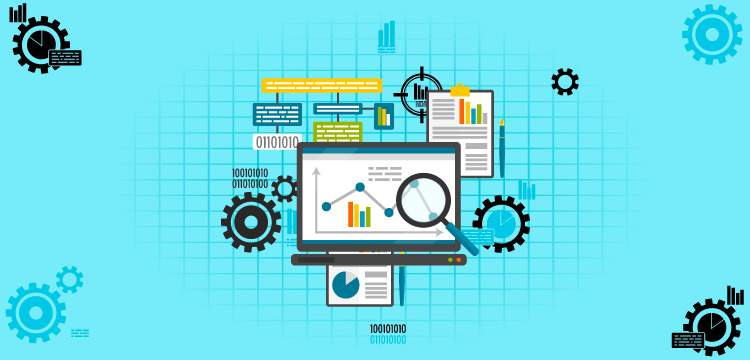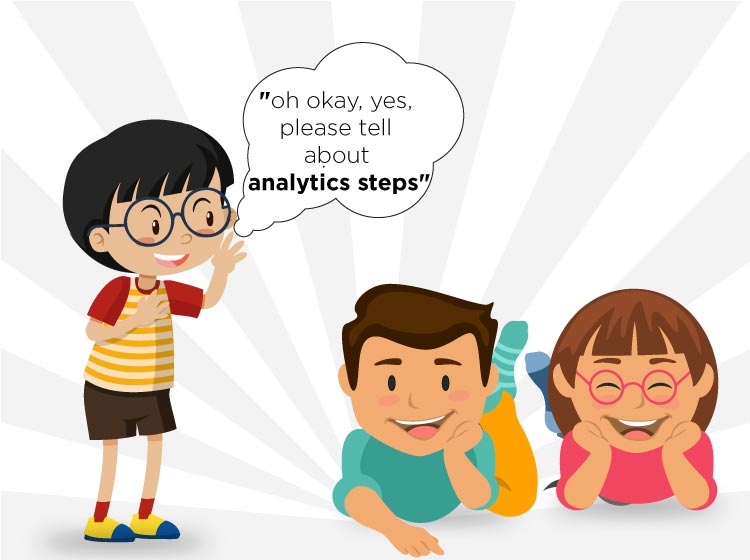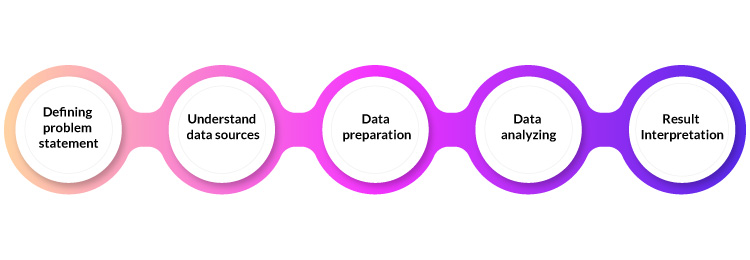- Category
- >Machine Learning
Decisive Analytical Initiative: 5 Leading Steps towards Qualitative Data Analytics
- Rahul Gupta
- Sep 25, 2019

“If we have data, let’s look at data. If all we have are opinions, let’s go with mine.” – Jim Barksdale, former Netscape CEO
We know that data is so important to many diverse sectors from manufacturing to energy grids, this not only helps in the understanding of the workflow of any company but also helps in improving their performance throughout all the time, we will see in this blog, how data behaves differently with respect to each step in the succeeding direction of analytics. We will also discover each analytical step in detail with some questionnaires.
Introduction to Data Analytics
For various stages of the Business analysis, data acts as a fuel for its implemented growth and continuous development, this enables any organization to stay ahead in the competition, from the view of different stages of workflow, structures, and its crucial role in each step of processing of data, the analysis itself is a complex process which can be cracked into simpler one for its smooth functioning. For any organization, there are so many resources available for getting and access data easily. Any single dataset contains much information to make a clear decision. The analysis gives an idea of what’s going on in the organization, and what possible steps should be taken to optimize the functioning. This is only possible when an appropriate analytical technique is adopted for getting information from data and provides more valuable insights to the organization.
A traditional way of handling any business is changing due to real-time business analysis by building proactive decision-making, this gives perfect direction to a leading business. Real-times analysis becomes a significant tool for any industry where data can be fetched and analyzed easily The data would be used for any purpose, such as customer behavioural analytics for improving customer services well as an organization’s performance to production management, and many other benefits.

Starting with the steps of data analysis
Steps involved in Data Analysis
Whenever any business analytics is implemented, major outcomes are almost the same, to solve any business problem using any relevant data and getting insights, giving the organization needed information for making a required business decision in order to give an organization an independent and competitive advantage in the market. Before diving deep in any decision-making by real-time analysis, an individual should consider some steps, here we are discussing a thorough process for data analysis, we have listed major steps for analyzing data, these steps not only introduce you to critical and challenging steps in any business but also give you an idea of how to make a better business decision, although these steps are interrelated, instead, each step would give different insight.
So, what is business analytics and how to resolve any business issue? Or you would say the necessary steps required to solve any analytical problem. Can you answer these questions without knowing why we are solving this? Or what is the objective to solve this? Probably no, even though we are aware of the fact that “efforts will be fruitful in the direction of goal”, and yes, objective or goal, or you can say “problem statement” in the case of business analytics. Here, proceeding in the direction of data analytics, we catch the first step, i.e. the problem statement, essentially the business analytics is 5-step process; (You can also sneak a glance at our blog on Real-World Applications of Business Analytics)
- Defining problem statement
- Understand data sources
- Data preparation
- Data analyzing
- Result Interpretation

5-steps process for data analysis
Each of these steps has its own significance and challenges, to overcome these challenges, each step should be understood deeply, further let’s initiate each step with introspective questions for better understanding;
Step 1: Defining Problem Statement
1st ask these questions, “what are you trying to achieve?” or “what are you looking for?” and “how your final result looks like”? This probably gives you an initial step or approach in considering what I would need, how to start and what could be a possible outcome, starting with the proper and realistic goal will prevent you from wasting time, reduce extra irrelevant analyzing as you move through data processing.
Step 2: Understanding data sources
“With data collection, ‘the sooner the better’ is always the best answer.” – Marissa Mayer
Starting with “What is the needed information?” or “From where I need such relevant data?” As the data is available at various sources, you need to combine all information from these sources, there might be a high chance that a part of the information is missing for which you want to test, so you need additional information for your test to be done. For example, you want to check the transaction on the weekend, the available dataset contains only data and time information, additionally, you need the amount of each transaction, who processed particular transactions, etc.
Above is a small brief on data information, next we see how to get data if you have required access and adequate practice on the methods, you may easily get data yourself, but what else if you don’t have? You could ask an IT department of your organization to help you in getting relevant data, making sure to give clear instructions to the IT department on the data.
Step 3: Data preparation
Now, what you come to know by this step, “Does the data need cleaning and normalizing?” and the answer is yes, let’s understand how; From step 2, it is clear that data is collected from multiple sources and might be structured or unstructured, depending upon the condition of how you want to process it, most of the time structured data would prefer for doing analysis. So, data needs to be cleaned with some cleaning exercises and covert data in the required format. Cleaning of data provides you qualitative information. Now, come to the process of normalizing the data, it will eliminate repetitions. Normalizing also a part of cleansing the data, the difference is it scans for the different variants of the same data entry, e.g. different date formats in different columns, it transforms all the variations into a single format.
Data preparation is the most important part of data analysis, it will take almost 60-70% time to prepare data itself of the complete analytic process. (Speaking of data analysis you might like to take a look at our blog on How to do Exploratory Data Analysis before building Machine Learning models?)
So, a good approach is required to prepare data that saves us from last-minute surprises and revise the whole analysis process. The output will produce an error, or the results will be unreliable if you don’t clean and normalize the data.
Step 4: Data Analyzing
You have come up with an objective, needed information of data and also spent some time on data cleaning and normalizing, you have a little idea about what information you can get from data, further, you need to explore data to identify trends and patterns, now try to answer “ do you know which test should be run on data?” or “ which is appropriate statistical tool to execute here?” and “ is it helpful to understand data effectively.”
For a better perception of data, now, it's time to run the test, any analytics tools will assist in summarizing the information. You can find out all the factors related to the objective. In the data analyzing procedure, statistical analysis methods (correlation analysis or testing hypothesis testing) or simple regression analysis (linear or logistic regression) preferably used in machine learning, get performed for predictions and compared using different assumptions, also the data is reduced and divided and many measurements are performed while making actionable insights from the data and get the desired result.
Step 5: Result Interpretation
In the final step, you need to finalize your model and hence interpret results, ask yourself,” How to showcase the result”? Before that make sure “ Does the data answer the objective?”, and ``Is there any limitation in your conclusion?”, Hopefully, interpretation of results holds these answers, use the details of the result to end up with an analysis process to decide your best course of action. In line up with result visualization, avoid presenting results with tables full of numbers, instead, use charts, graphs, and bars with simple notes in the form of dashboard-like Tableau, Excel, etc. for effective communication along with results.

Understood the data analysis process
Conclusion
I hope this blog was able to bring clarity of steps required for any business analytics procedure, I summarized the entire procedure in five steps for easy understanding. Each step covered with introspective questions and contained much information to end up with a successful and implemented analysis as every step is performing a key function in generating important insights. For more blogs in Analytics and new technologies do read Analytics Steps.
Trending blogs
5 Factors Influencing Consumer Behavior
READ MOREElasticity of Demand and its Types
READ MOREAn Overview of Descriptive Analysis
READ MOREWhat is PESTLE Analysis? Everything you need to know about it
READ MOREWhat is Managerial Economics? Definition, Types, Nature, Principles, and Scope
READ MORE5 Factors Affecting the Price Elasticity of Demand (PED)
READ MORE6 Major Branches of Artificial Intelligence (AI)
READ MOREScope of Managerial Economics
READ MOREDifferent Types of Research Methods
READ MOREDijkstra’s Algorithm: The Shortest Path Algorithm
READ MORE

Latest Comments